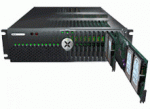Next week, I head to Redmond Washington for the annual Microsoft MVP Summit. This is always a fantastic event, full of technical information (sadly, much under NDA) and great people. I look forward to learning more about Windows Server storage technologies like ReFS, Storage Spaces, SMB 2.2, and more.
GreenBytes introduces Solidarity, an all-SSD storage array
GreenBytes has evolved from software company to storage array company and proven itself able to survive in the cutthroat storage market. It remains to be seen whether the they can convince customers to take Solidarity seriously, but the introduction of this product was the right move for the company. We will be watching and hoping that they will add VMware compatibility and more capacity.
Reminiscing About the Cubix ERS, My First Bladed Server System
The Cubix ERS/FT was a great little system at the time. It really improved availability and performance of my cc:Mail system and cleaned up the data center at the same time. Although not quite as flexible as a modern blade server system, the Cubix ERS should go down in history as a worthy predecessor.
Where Did Blade Servers Come From?
Most folks credit RLX Technologies with inventing the modern blade system, but the history of this technology began well before RLX was founded. Companies like Egenera, Cubix, and Sun were influential in the history of blade servers as well.
What Is a Blade Server?
In the server space, one of the biggest shifts was the form factor of the servers: From tower to rack-mount to blades. But what makes a blade server anyway? Let’s consider this for a moment, as we watch another shift in progress.




